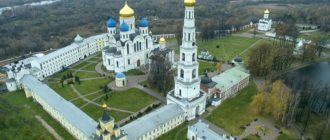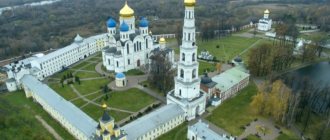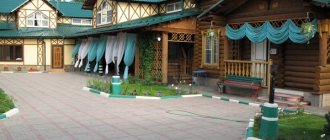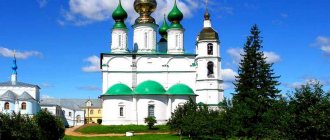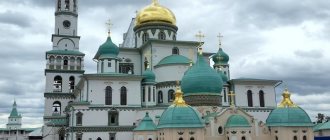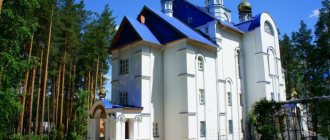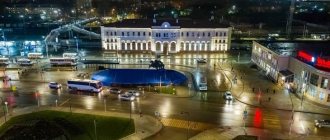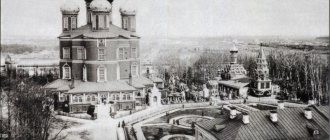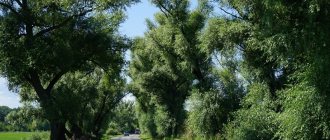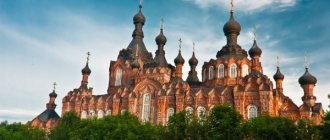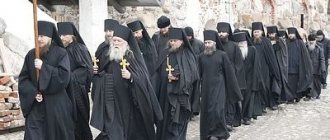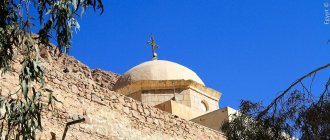Description
On St. Nicholas Square in the center of the city of Dzerzhinsky there is the ancient Nikolo-Ugreshsky Monastery, founded, like many monasteries of that time, in honor of the victory on the Kulikovo Field. This is one of the places of worship, often visited by royalty and patriarchs. In troubled times, the monastery was besieged, burned and plundered, but, fortunately, the Nikolo-Ugreshsky Monastery survived.
You can also visit two museums in the monastery. The Museum-Sacristy presents the treasures of the sacristy of the monastery, where a significant place is occupied by a collection of icons. And the Museum of Passion-Bearer Emperor Nicholas II contains various things - photographs, books, household items - associated with the family of the last Russian emperor.
Shrines of the monastery
The monastery contains shrines revered by the Orthodox:
- Tikhvin Icon of the Mother of God, prayer image of Patriarch Alexy II, donated to the monastery.
- The relics of the Great Martyr Barbara, the Great Martyr Panteleimon the Healer, John the Baptist, the Kiev-Pechersk saints and many more saints.
- Relics of St. Nicholas the Wonderworker.
- Relics of the Venerable Pimen of Ugresh.
- A copy of the icon of St. Nicholas the Pleasant, painted in the 19th century, who appeared to Prince Dmitry. The original is now kept in the Tretyakov Gallery.
- Ark with the relics of St. Ignatius (Brianchaninov).
- Reliquary cross of the 7th century.
Drawing. 4. Reliquary with the relics of St. Pimen in the Transfiguration Cathedral
Telephone:
This information was last updated over a year ago.
If you are the owner or representative of this organization, you can log in (register) on the site, confirm management rights (section “Restoring Access” in your Personal Account) and make the necessary changes.
Nikolo – Ugreshsky Monastery
Today, Nikolo - Ugreshsky Temple will captivate anyone who wants to visit it for the first time. This is a royal, most beautiful and sacred monastery. Being in its area gives you a special atmosphere of self-enlightenment and peace of mind. It may seem at first glance that nothing bad has ever happened in this monastery. However, this sacred ensemble was recently resurrected from ruins and desolation. Thus, we have the great honor to visit this delightful monastery, read a prayer, visit all the sanctuaries, and baptize the baby. Request support from the Almighty Lord or perform the ritual of the sacrament in the Nikolo-Ugreshsky temple, in this beautiful Christian temple of our state.
History of the monastery
In the 14th century, Russian lands were under the yoke of the Tatars and Mongols. Prince Donskoy gathered an army of 70 thousand soldiers and set out to liberate Rus' from the Golden Horde. According to legend, the prince and his army stopped for a rest. And at that moment a vision appeared to him. And then the prince said: “This whole sin has sinned my heart.” The place subsequently became known as Ugresha. After the victory, the prince ordered the construction of a monastery in the name of St. Nicholas the Wonderworker. The monastery was built. But his fate was not smooth and calm. More than once the monastery was destroyed, burned and rebuilt again. The welfare of the monastery fell into decline and again soared to heaven.
In 1521, the monastery was burned down during a Mongol raid. But soon it was restored again. The monastery was often visited by Moscow rulers. Therefore, forests and villages were donated to him. Also, by royal charter he was exempted from trade duties.
In the 17th century, the monastery was often visited by royal officials. This helped with numerous donations to restore and expand the buildings. By the middle of the century, the Nikolo-Ugreshsky Monastery reached the peak of its glory. In 1676, at the crowning ceremony, the Ugresh abbot presented the scepter to the patriarch. This indicates the high status of the monastery at that time.
During the reign of Catherine II, the monastery was deprived of all lands and wealth. At that time, it almost closed completely.
The Bolsheviks deprived the monastery of all property. Then the confiscation of valuables began. The monastery was completely destroyed and a children's colony was formed in it. During the beginning of Soviet power, many churches were plundered and destroyed. Valuable icons were lost. Many artifacts were burned. In the mid-19th century, the main temple was completely destroyed. Restoration work began in 1950. 6 churches and a chapel survived into the 20th century.
In the 90s, it was decided to restore the monastery completely. At that time he made a deplorable impression. Decapitated towers, crumbling walls, weeds inside and outside buildings. There were many people willing to help. By the end of the 20th century, a theological seminary and library were already operating, and the restoration and restoration of churches was in full swing.
Today the monastery is one of the most beautiful in Russia. The entrance to the monastery is a 17th-century tower. Before entering you can take long skirts and scarves. There is also a souvenir shop here. Inside, throughout the area, there are beautiful rose gardens.
Video: Tour of the monastery
Chronicle of Nikolo - Ugresh Temple
Once, while driving on the road to the Kulikovo Field, to a duel with the Mongols (fifteen miles from the city of Moscow), the Russian ruler Dimitri Donskoy noticed the image of St. Nicholas the Wonderworker on a pine tree. The ruler, generals and all the soldiers offered prayers to the miraculous icon. Then Demetrius cried out, “This is all a sin to his soul.” From that period, the icon began to be called Ugresha. The Russian prince won the battle. Subsequently, after the victory, Demetrius gave the order in the area where the image was discovered to build a monastery in honor of St. Nicholas the Wonderworker for gratitude for the famous victory.
The monastery was founded in 1380. In the fifteenth century, an inn was opened in the Kremlin. In 1521, the structure was incinerated by the Mongol ruler during an attack. However, the Moscow ruler immediately gave an order to restore the temple.
In the seventeenth century, this monastery was at the peak of its popularity. All the great people visited him constantly. In this way, the monastery had the opportunity to replenish itself with impressive contributions and demonstrate its own highest condition.
At the end of the eighteenth century, the monastery acquired the miraculous image of the Blessed Mother of God “Leaping”. At the beginning of the next century, French soldiers took possession of the temple. However, without exception, all significant things were not damaged, because they were redirected to Vologda in advance.
Upon the arrival of the Russian government, a company began to confiscate monastic jewelry. Later, the elders were completely deprived of the right of residence, and hotels, secondary educational institutions, public eating places, factory workshops and other institutions were located in their buildings. In 1940, the main monastery was completely destroyed.
The restoration and revival of the sacred monastery began in the seventies. Before the end of the century, 6 temples, ten sanctuaries and thrones were restored.
Despite all this, in the nineties the situation of all monasteries was sad. For this reason, a resolution on intensive repairs was generally accepted, in which a large number of management persons and ordinary residents of the city took part. Through united efforts it was possible to create such a majestic monastery.
Temples and monastery plan
Architectural ensemble of the monastery:
- The oldest building of the monastery is considered to be the bell tower (Ugreshskaya candle) 77 meters high. Which was partially destroyed during the Second World War for strategic military reasons, but in the 20th century it was restored.
- Chapel of the appearance of the image of St. Nicholas the Wonderworker, built in the 19th century. Pilgrims can collect holy water there.
- In the 18th century Sovereign and Patriarchal chambers were built for the kings and patriarchs who came here. They are located next to the monastery belfry and also belong to the antiquities of the monastery.
- Assumption Church (1763). In the 19th century a border was built in honor of the Venerable Mary of Egypt.
- Palestine Wall (1866). The Monk Pimen built it in such a way that its entire appearance would remind one of the temples and buildings in the holy city of Jerusalem.
- At the same time, a monastery monastery was built in honor of the apostles Peter and Paul. It had very strict rules back then. It still works today. The Peter and Paul Church, located in the monastery, is the only building at the monastery made entirely of wood.
- Spaso-Preobrazhensky Cathedral (1880), the construction of which began under St. Pimen and ended in 1894. It is one of the largest churches in Russia. Built in Russian-Byzantine style.
- Cathedral of St. Nicholas the Wonderworker (2006) is a copy of the very first temple.
- Church of the Apostle Matthew and Paraskeva Pyatnitsa (1854).
- Pimenovsky Temple (2002).
- Church of the Icon of the Blessed Virgin Mary “Joy of All Who Sorrow” (1860).
- Church of the Beheading of the Baptist John, which is located in the monastery belfry.
- Temple in honor of the icon of the Mother of God “Seeking the Lost” (2001).
Drawing. 3. Plan - diagram of the monastery
Schedule of services in Ugresh
The following activities are carried out daily on the premises:
• Every day at seven o'clock in the morning the Eucharist takes place;
• Morning and evening services at five o'clock in the evening;
• Every week on Thursday a hymn to Nicholas is read;
• Every week on Sunday a hymn to the Tikhvin icon is read;
• Every week on Friday in the evening service the “Inexhaustible Chalice” is read with an akathist to the image;
• On solemn days and on Sundays, the Eucharist is celebrated in the morning at six hours thirty minutes and at nine thirty minutes.
Divine services
Divine services are held daily at the monastery.
Table 1. Divine Liturgy
| Day of the week | Time and worship | Temple |
| Weekdays | 6:45 Divine Liturgy and memorial service. 9:00 BL* and prayer service | Assumption Church. Pimenovsky Temple (in warm weather), Kazan Temple (in cold weather) |
| Sundays and holidays | 6:30 BL. 8:00 BL. 9:30 BC and water prayer service | Assumption Church. Pimenovsky Temple. Transfiguration Cathedral |
* BL - Divine Liturgy
Every week during the Divine Service the following akathists are read:
- on Tuesday - Rev. Pimen;
- on Thursday - Nikolai Ugodnik;
- On Sunday, during the evening service, an akathist to the Tikhvin Icon of the Mother of God is read.
On Fridays at 17:00 there is a prayer service for water and an akathist to the Mother of God in front of her image, called the “Inexhaustible Chalice,” about dependence on alcohol.
Where is it located and how to get to the monastery?
You can get to the Nikolo-Ugreshsky Temple in several ways:
• You need to get from the Kazansky railway station to Lyubertsy Square, and then by public transport (bus) number 20 and number 21 you need to get to the stop St. Nicholas Square;
• It is possible to get from the Lyublino metro station by public transport number 305;
• Can be reached from Kuzminki metro station by public transport number 470.
Any religious person is obliged to visit this abode of the Lord at least once, to feel this supportive serene environment, to look at absolutely all the holy of holies, sanctuaries, monasteries, cathedrals, chapels and images of the Nikolo-Ugreshsky temple. In order to verify the strength of this majestic area without the help of others.
May the Almighty always protect and protect you!
Temples of the Nikolo-Ugreshki monastery and chapels
There are majestic temples on the territory of the community:
- Dormition of the Virgin Mary;
- Saint Matthew and Paraskeva;
- St. Sergius of Radonezh;
- Alexander Nevsky;
- Ioanna Predchiti;
- Transfiguration of the Savior;
- Peter and Paul;
- Holy Spirit;
- Panteleimon;
- Kazan Icon of the Mother of God;
- Icons of the Mother of God “Joy of All Who Sorrow”;
- Chapel of the Icon of Our Lady “Recovery of the Lost;
- Chapel of the appearance of the icon to Prince Donskoy.
Shrines and icons of Ugresi
On the territory of the monastery of God there are also significant shrines:
- relics of John the Baptist;
- relics of Panteleimon;
- the relics of Pimen Ugreshsky;
- part of the relics of St. Nicholas the Wonderworker;
- relics of Ignatius Brianchaninov;
- and many other saints and saints.
Icons are kept in the churches: Leaping of Ugreshskaya, St. Nicholas the Wonderworker and a list of the Tikhvin icon.
